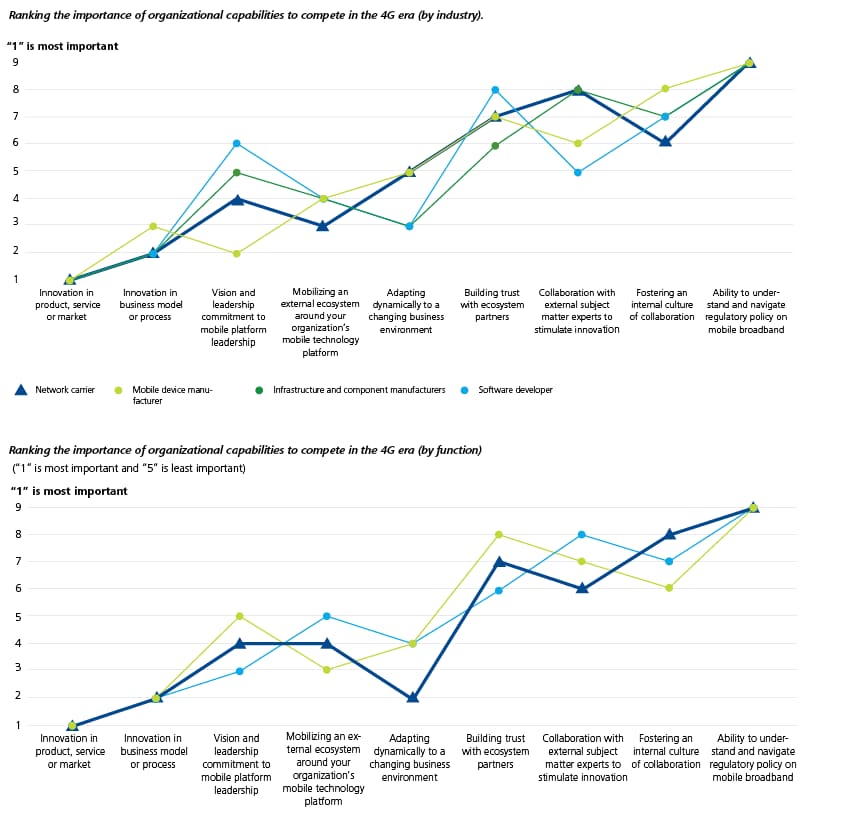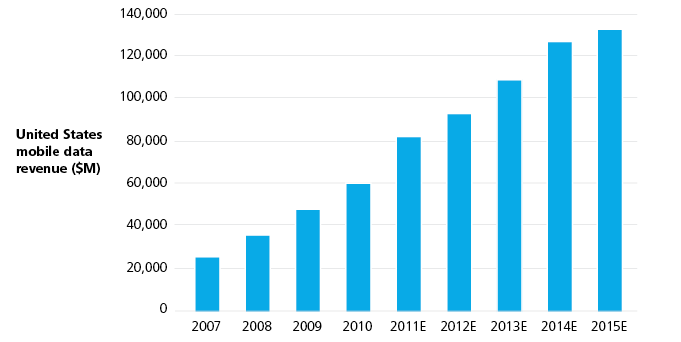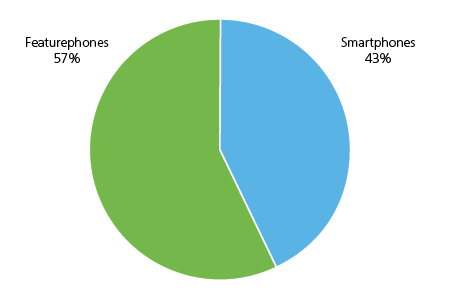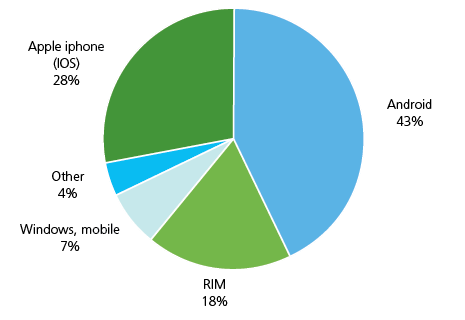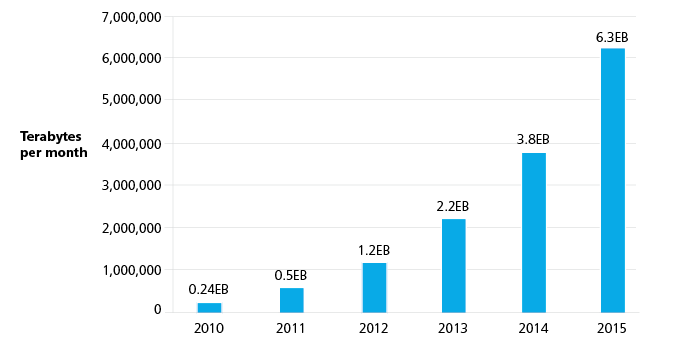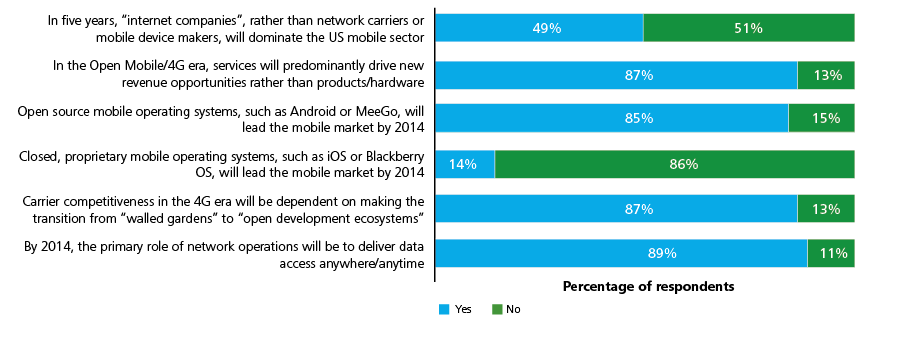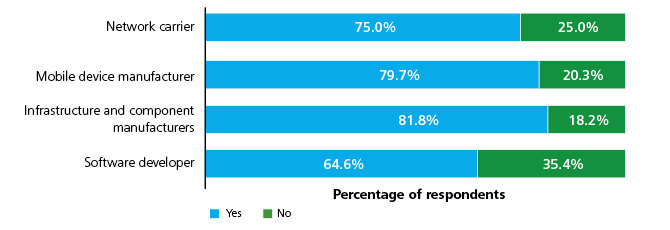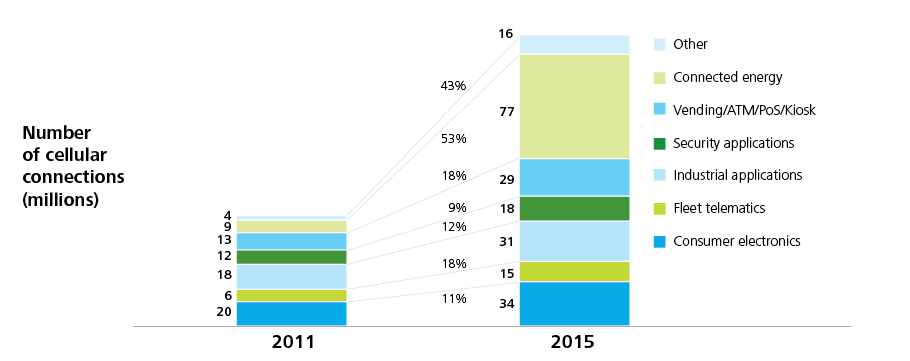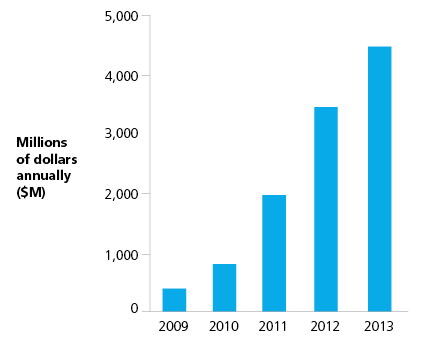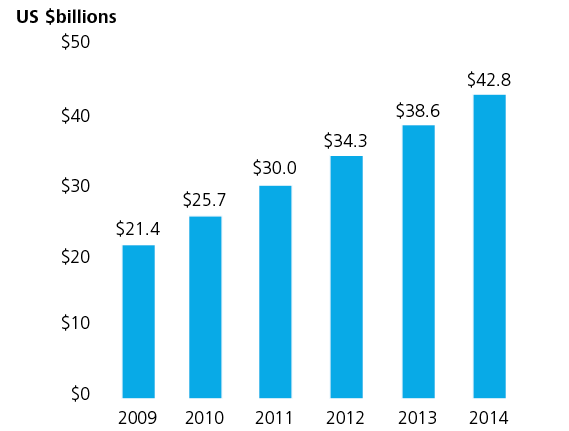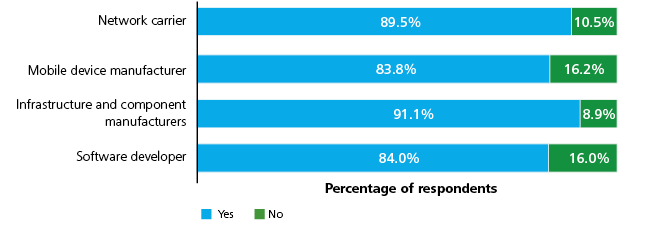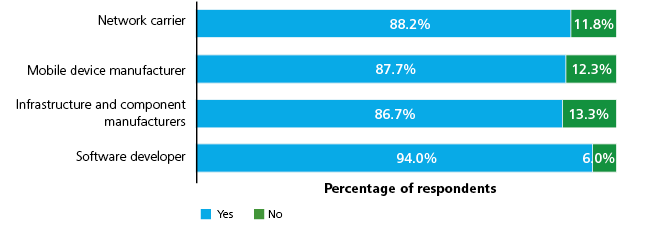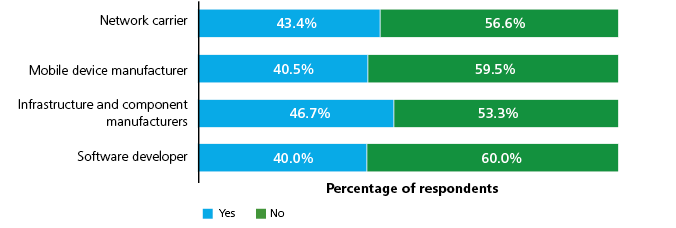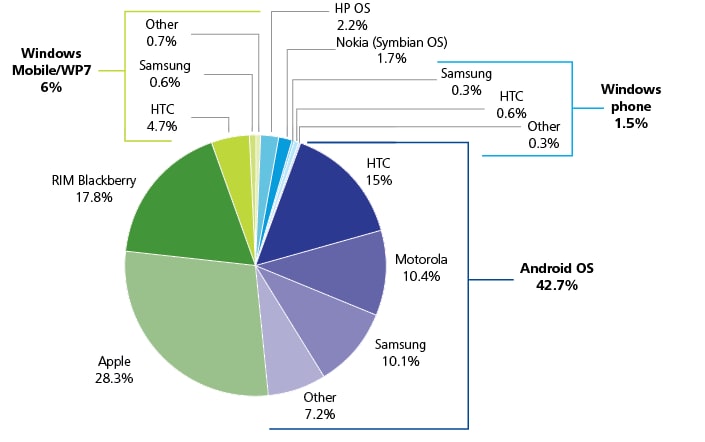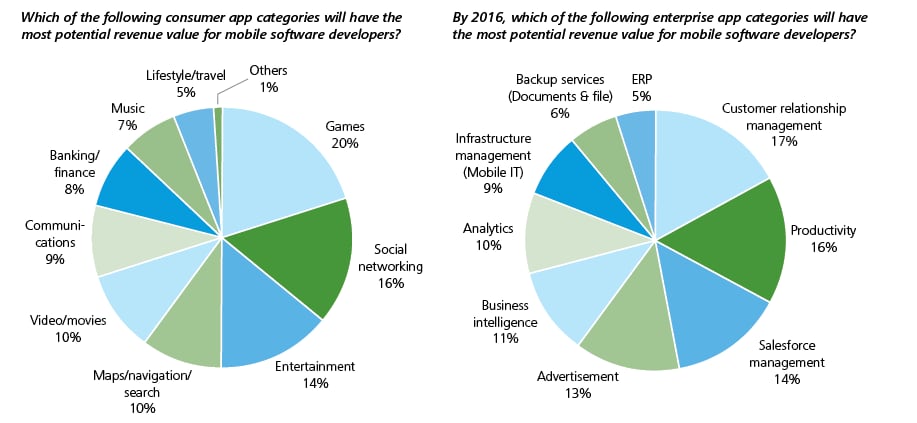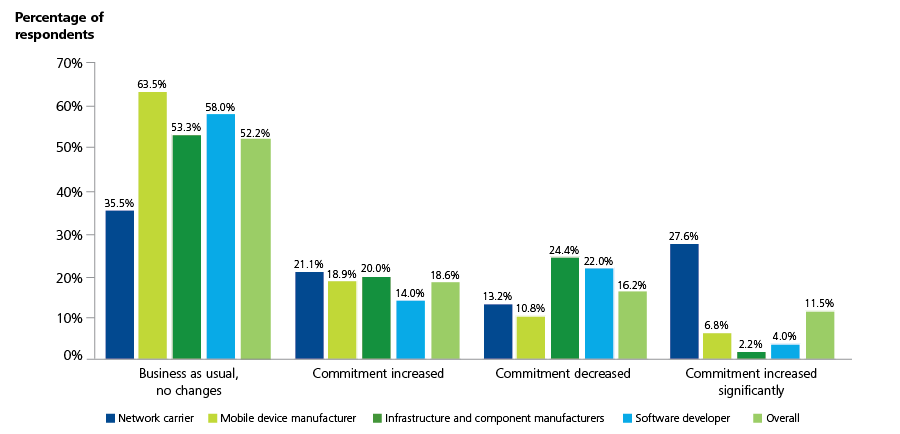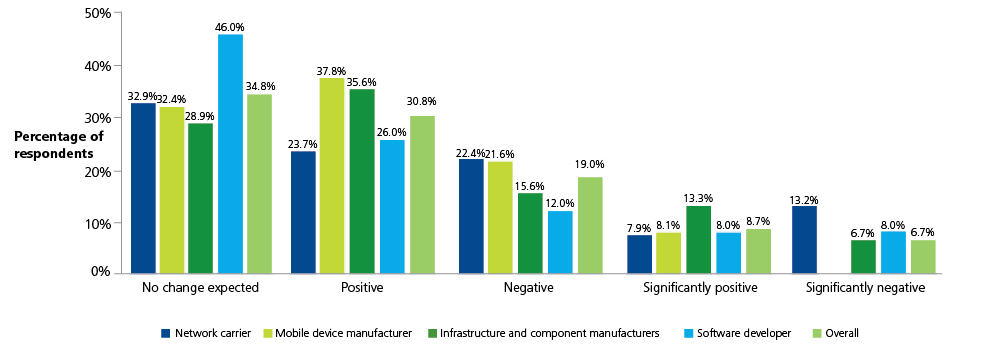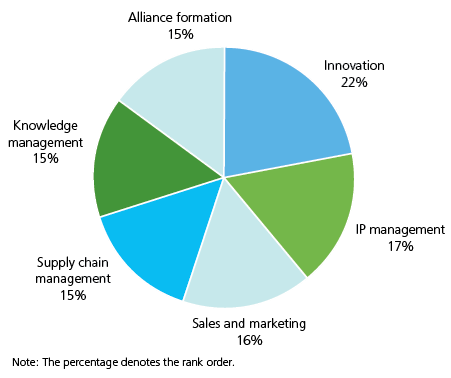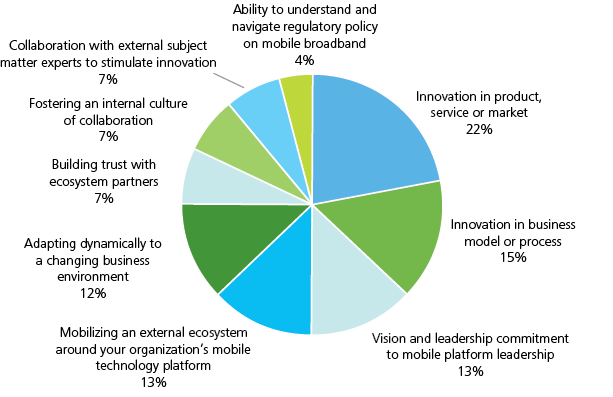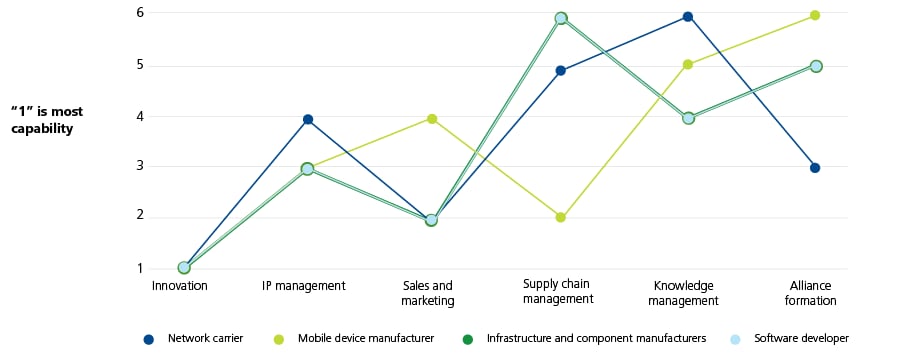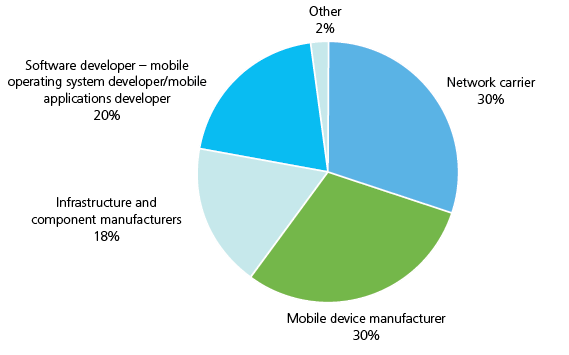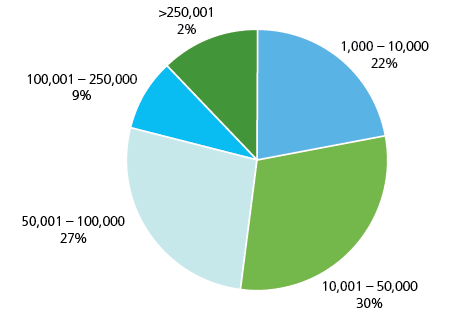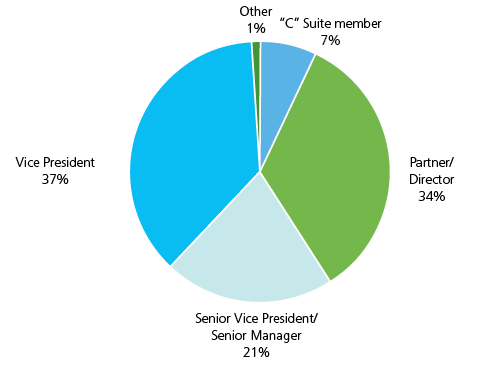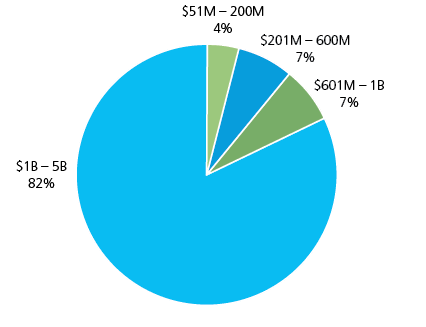Open Mobile: The Growth Era Accelerates has been saved

Open Mobile: The Growth Era Accelerates The Deloitte open mobile survey 2012
02 January 2012
- Scott Wilson, PhD
Based on a highly targeted survey of senior executives from the U.S. mobile sector, this study offers insight and guidance on maintaining competitiveness in the face of heightened market competition and technological disruption. With the arrival of the 4G era and hypercompetition, the core elements of open mobile remain very much in flux—leading to the issues of competitiveness, growth and innovation becoming the key themes of exploration for this year’s research.
Executive summary
Mobility is seemingly everywhere, and with the growing ubiquity comes a set of unique challenges for companies riding the mobile wave of opportunity.
This study is the latest in a series of ongoing mobile research reports that offer insight and guidance on maintaining competitiveness in the face of heightened market competition and technological disruption. At the core of the study is a survey on the impact of open mobile over the next three to five years. Issues covered include the transformation of the planning, preparation, and overall strategy formulation process in mobile technology-oriented companies today. The survey checks the pulse of companies in the throes of transitioning from closed business models to a more open, collaborative approach to competing in the mobile 4G era.
The headlines this year reflect the pressing need for incumbents to secure viable pathways to growth or risk being marginalized by a growing army of new entrants from non-traditional mobile industries. To that end, the majority of our survey respondents believe network carrier competitiveness in the 4G era will depend on accelerating the transition from the old, tightly-controlled “walled gardens” of the past to a more distributed approach to business model development. However, open mobile requires more than paying lip service to the idea of looking beyond the four walls of an organization for inspiration. It requires a shift in mindset away from the “old wireless” school of competition to help companies adopt fresh thinking and compete in the new “hypercompetitive” wireless era. The days of divide, conquer, and protect are fast disappearing and only those agile enough to change will survive.
Among the report’s findings:
The change in the mobile power structure is accelerating—new entrants continue to rewrite the rules of competition:
Forty-nine percent of the respondents believe that Internet/Web-based companies, rather than network carriers or handset makers, will dominate mobile in five years. Moreover, 89 percent believe the role of carriers will be limited to delivering data access anywhere, anytime. Meanwhile, 87 percent state that to sustain competitiveness, carriers must make the transition from the walled gardens of the past to new organizational models built around open development ecosystems.
Mobile services are poised to dominate future revenue opportunities—mobile cloud, M2M, and mobile payments—thought to hold most value potential:
Fifty-one percent of the respondents thought that in the short term, mobile services in areas such as social media and networking, location-based technologies, and general mobile commerce will have more potential value than sub-segments such as mobile search advertising, display advertising, and mobile software applications. Digging deeper, most think mobile cloud computing and mobile payments hold the highest potential for carrier value generation in the next three years, closely followed by the increased utilization of machine-to-machine (M2M) technologies. With regards to the app economy, gaming is thought to be the most lucrative category for paid applications five years out, while apps for social networking, broad-based entertainment, and mobile navigation round out the top four. In the enterprise apps category, customer relationship management (CRM) apps are thought to hold the most potential value for developers in the next five years, closely followed by apps in the productivity category. Finally, 85 percent of the respondents believe the long-anticipated arrival of HTML 5 is unlikely to impact the general health of the paid app economy.
Healthcare sector thought to be the most promising new mobile growth channel:
Survey respondents were asked to nominate the top three vertical industries where they thought 4G technology would have the biggest impact in stimulating mobile business model innovation—increasing the potential for value generation outside of traditional mobile and wireless markets in the process. Of those polled, 78 percent stated that the health care/life sciences sector held the greatest potential, with the consumer products/retail industry and financial services/commerce also considered prime sectors set to benefit most from the emergence of 4G broadband technology.
Economic downturn yet to have an impact on planning for open mobile:
On the subject of strategizing for the anticipated opportunities, survey respondents reported that the recent economic downturn had not affected their organizations’ commitment to planning for the open mobile era. Indeed, while 52 percent stated it was still very much business as usual, 31 percent reported that their individual company’s commitment had increased or increased significantly, despite challenging economic conditions. At the industry level, this increased commitment was most apparent among network carriers, with 48 percent reporting an uptick in open mobile planning commitment.
Potential shifts in regulatory policy not seen as a hurdle to market competitiveness:
Other elements of the competitive landscape, such as regulatory policy, were also explored in the context of planning and potential impact on revenue. Respondents, on the whole, think revenue generation opportunities will not be negatively affected by any new policy shifts in the area of broadband net neutrality. While 40 percent believe that new policies in this area will enhance sector-wide revenue generation, 35 percent thought the current status quo would be maintained, despite any changes implemented by the FCC in this area. Perhaps unsurprisingly, given their current position in the debate, respondents from network carrier companies were most skeptical; 36 percent believed that proposed shifts in policy will have a negative or significantly negative effect in this area.
Mobile carriers urged to follow a managed open strategy to sustain competitive advantage:
Respondents debated the best course of action for network carriers to sustain competitive advantage in the next three to five years. A majority believed that a managed open strategy, where carriers retain prioritized control over premium assets and grant third parties access to selected core network functions, would be the most likely route to sustained success. This contrasts with providing full and open access to consumers, allowing the use of any third party device and application for a flat fee, which 27 percent of the respondents suggested would be the next best route to enhancing competitive advantage.
Innovation and platform leadership thought to be the two most important capabilities in mobile:
From a growth and performance perspective, respondents were asked to select capabilities that will enable competitiveness in the emerging 4G era. The capability to innovate—at the product or service level and/or at the business model level—was thought to be most critical, followed by the need for vision and commitment to platform leadership. Respondents were then asked to rank their own organizations’ capabilities across a number of business function areas, and, again, innovation topped the list, both in terms of aggregated average and sub-industry categories.
User experience and cross-industry potential seen as critical factors for the success of mobile platform strategies:
Sixty-seven percent of survey respondents work in organizations that either had or were planning to have an open mobile strategy in operation. Questions were asked on the broader role of platform leadership within that strategy. An average of 65 percent reported that their organizations had already developed what they considered a mobile technology platform. A discussion on the top three critical elements of the platform’s success then highlighted simplicity of application development and user experience, combined with cross-industry potential, as the most critical elements for success (62 percent). Use of open interface access and modular technology architectures was ranked next (52 percent), followed by the deployment of a vibrant ecosystem to support and develop the platform standard (45 percent).
Confusion abounds on the role and use of ecosystems—C-suite yet to buy in to the importance of an ecosystem strategy for platform success:
Interestingly, both network carriers (39 percent) and software developers (28 percent) ranked the use of ecosystems much lower in terms of platform success criteria. A further analytical cut by function/decision-making was even more revealing. Only 10 percent of C-suite respondents believed the use of ecosystems was a critical element. However, this seemed contrary to data collected on the most critical elements for value generation when developing a mobile OS platform. In this instance, the use of a large, developer ecosystem was deemed essential by 42 percent of respondents, beating large market penetration (24 percent). However, respondents at the C-suite level again lagged other functional roles in determining its value; only 29 percent were in agreement that it remains critical. This does not seem to have a lasting impact on the overall need for a mobile ecosystem strategy; 58 percent of respondents reported that their organizations have strategies in place for either playing a leading role in orchestrating an ecosystem (29 percent) or are a participating partner in one (29 percent). At the industry level, mobile device manufacturers lead the way, with 72 percent of device respondents either in companies orchestrating (42 percent) or participating (30 percent).
Increased knowledge and learning potential is the main incentive for ecosystem participation:
Also addressed were the incentives organizations use to attract partners to build or become members of an ecosystem network. Overwhelmingly, two main incentives were reported to ensure active participation: increased knowledge and learning potential and the promise of financially lucrative opportunities emerging in the future between ecosystem partners (termed “shadow of the future”). This remained consistent at the industry level with data aligned to each sub-segment, illustrating a consensus view on incentives.
Open source platforms continue to grow a powerful presence in the open mobile era:
An overwhelming majority (85 percent) of respondents believe an open platform OS such as Android, rather than closed OS platforms, will dominate the mobile OS market in three years. Similarly, the proliferation of open source technology throughout the U.S. mobile sector is predicted to remain in a steady uptick; 59 percent of the survey respondents believe their organization’s investment in open source technologies will increase or increase significantly in the next three years. Respondents cited the benefits of adoption being twofold: improved time-to-market and reduced total cost of software development and ownership. On the other hand, 64 percent of the respondents view security as an obstacle when adopting an open source strategy—more so with network carriers, 70 percent of which believe that security remains a serious issue with open source technologies. In discussing OS platform growth, 58 percent of the survey respondents do not believe the issue of OS fragmentation will stymie platform innovation.
The report concludes by identifying the broad strategic focal points that incumbents should consider to remain competitive in the open mobile era. The guidance provides executives with a lead-in to forthcoming open mobile studies focused on tactics for ecosystem development and platform leadership across and beyond the mobile industry.
About the Deloitte Research Open Mobile Series
Since 2009, the Technology, Media and Telecommunications team in Deloitte Research has explored the advent of the open mobile era and the subsequent shifting competitive landscape in the United States and global mobile markets. The team has produced a number of research reports and whitepapers on a wide range of strategic issues mobile technology companies face in this increasingly turbulent industry. For more details on our current research and free downloads of all our reports, please visit: www.deloitte.com/us/openmobile.
Open mobile redux
Attitudes in mobile shift quickly—even among those once skeptical of change. In 2009, Deloitte Research published two inaugural reports on competitiveness in the new “open mobile” telecoms era. We defined open mobile as a macro-level phenomenon that reaches beyond the boundaries of the traditional U.S. mobile industry, with the accompanying disruptive market shifts being felt deep in the surrounding technology and media sectors. At the core of this volatility, a patchwork of seismic events is unfolding around three pillars of change: the rapid acceleration of innovative mobile Web technology; insatiable consumer demand for new mobile products and data services; and an evolving regulatory policy debate pushed along by the FCC, which seems dedicated to pursuing a more open, competitive market environment—the likes of which the industry is yet to experience.
“A tidal wave is coming with 4G and customers are going to do what they want. Our objective is to make this seamless and open as possible.”1- Randall Stephenson, CEO AT&T, Mobile World Congress, 2011
Back then, the first two reports—The Promise of Open Mobile and The Democratization of Wireless: Assessing the Impact of Open mobile —concentrated on engaging a select group of senior executives across a range of companies in and around the U.S. mobile telecoms sector. Our goal was to take the pulse of the industry on the likely impact of open mobile on the competitive landscape. In parallel, we also wanted to explore how companies were preparing to transition to an era marked by strategic uncertainty and the looming prospect of hypercompetition.2 The findings provided a strong correlation to our underlying hypothesis: the locus of innovation in mobile telecoms has shifted to Silicon Valley. Network carriers in particular will have to unshackle from the walled gardens of the past and embrace unfamiliar pathways for future revenue growth and compete with the new world order of Google and Apple.
Emerging insight themes
Findings from this new study continue to analyze the impact of the turbulence across mobile’s competitive landscape. The data provides another clarion call for incumbents to act, and act quickly. Growth and innovation are again the dominant issues of the day. The gentle breeze of change is long gone, and in its place, a full-blown (Schumpeterian) headwind threatens to leave a trail of creative destruction in its wake. Incumbents are seemingly challenged on an almost daily basis by floods of new entrants, many with limited prior knowledge or experience in developing mobile-technology-based business models3—proof that experience is no harbinger of success in this mobile era.
From an insight perspective, this study focuses on three levels of analysis—industry, value chain, and firm capabilities, which together comprise the basic tenets of competitive advantage4—to illustrate emerging growth areas beyond the traditional wireless boundaries. Identifying these new beacons of revenue generation is critical when incumbents are attempting to regenerate top-line growth. Innovative wireless opportunities in industries such as healthcare and life sciences, energy, consumer products, and financial services are set to propel key players in these verticals to the forefront of mobile business model innovation, and, in the process, provide a significant revenue opportunity for mobile incumbents buckling under pressure from shareholders to grow.
The concept of “open” once more permeates across the value chain and capabilities levels of analysis of tactics used to gain competitive advantage. In turbulent sectors, resources, often more so than market position, can be the determining factor for success. Now more than ever, new organizational capabilities are required to compete and capitalize on new opportunities. But in what areas, and to what extent, should strategic approaches be built upon open or closed methods of platform development, collaboration with third parties, alliance formation, and intellectual property management? Perhaps unsurprisingly, innovation, or the notion of innovation, is the dominant strategic theme running through these questions. But in this year’s study, it seems confusion abounds on how to get beyond running hard to stand still on the innovation treadmill. Recognition of the importance of innovation to an organization is clear; a majority of survey respondents rank it as their company’s leading capability, but what is not so clear is how to amplify and sustain this capability.
What is also evident from our survey findings is the expanded role of new platform and ecosystem development to support top-line growth and innovation initiatives. But understanding the role capabilities play in deploying these strategies remains inconsistent to say the least. At the heart of this issue lies a growing tentativeness among incumbents to fully embrace open platform tactics. Carriers, in particular, seem hesitant to exploit the tactic of open collaboration through co-opetition5 to explore growth opportunities beyond traditional network assets above the level of the mobile operating system (OS). Trust in partnering on a collaborative, open basis is lagging, and concerns that new products and services developed at the OS level will harm traditional network revenues, seem to be lingering. This needs to change if incumbents want to avoid a long, arduous road to maintaining their dominance. Mobilizing and managing new open ecosystems becomes crucial to business model innovation, especially in light of recent sector events that are rapidly redrawing the competitive landscape.
Source: Deloitte Open Mobile Analysis.
Figure 1. Ranking key organizational capabilities in the 4G era
The hypercompetitive mobile sector
So significant is the accelerated rate of development in mobile Web technology that the wireless sector now finds itself in a period of hypercompetition. The rate at which established markets are being threatened by new entrants wielding disruptive technologies shows no sign of slowing down. This in turn is causing traditional standards and established market “rules” to remain volatile, putting established competitive advantages and profits at risk over a sustained period of time. Viewed through an open mobile lens, the accelerated turbulence is a direct consequence of the shifts in technology, regulatory policy, and consumer demands sweeping the sector. Events in these areas have overlapped simultaneously, resulting in an almost black-swan-like episode emerging to push the industry toward a new, less restrictive, open era in market competition. As a result, mobile incumbents find themselves at a fork in the road: embrace the opportunities of a more democratized world or stoutly defend the business of yesterday and protect traditional revenue streams. However, the decision is not so black and white, and more than ever, the challenge is to be effective with both strategies. But first, incumbents must find new ways to compete against the wave of innovation emerging from Silicon Valley—one that has shifted the locus of innovation firmly to the West Coast.
Source: Gartner, Mobile Services, Worldwide, 2007-2015, 3Q 2011.
Figure 2. Total mobile data revenue, United States, 2007 – 2015E
These market data points highlight the challenges that hypercompetition will throw up for established incumbent wireless carriers. An overwhelming majority of the respondents—70 percent—think that Internet/Web-based companies, defined as companies in the Google and Apple mold, will come to dominate the mobile sector in five years. In the same vein, 31 percent of the survey respondents employed by network carriers thought the proposed changes in open access regulations would accelerate the commoditization of carriers, and an overwhelming 90 percent of the same group stated the traditional carrier “closed garden” (tightly controlled network/device/software platforms) business model is fast becoming a strategic relic. Instead, network carrier respondents think, the future of mobile rests on the proliferation of open platforms across multiple facets of the value chain. In particular, the opportunity to tap into the burgeoning mobile software applications market is deemed critical to success.
Source: Nielsen, Q3 2011, U.S.
Figure 3. U.S. mobile phone market penetration
Source: Nielsen, Q3 2011, U.S.
Figure 4. U.S. smartphone OS market share
Source: Cisco Visual Networking Index: Global Mobile Data Traffic Forecast Update, 2010-2015, February, 2011.
Figure 5. Cisco forecast 6.3 exabytes per month of mobile data traffic by 2015
Certainly, network carriers still seem slow to react to this reality, wary of a more progressive approach to the question of open versus tightly controlled platforms unlocking the flood gates to commoditization and turning them all into the dreaded “dumb pipe.” Part of this fear stems from continuing concerns over ceding too much control over revenue-generating content development to software developers and becoming even more of a bit player in the process. The fear of commoditization continues to lurk in the background, preventing carriers from reaching their full potential in mobile business model innovation, despite the significant increase in forecasted mobile data traffic, itself a direct consequence of mobile software innovation. And with 90 percent of survey respondents also believing that the role of the carrier will continue to be limited to pushing data bytes, the recognition that value in mobile now sits above basic connectivity is broadening. But where exactly will that value reside?
Accelerating into the 4G era
Very much the backbone of the open mobile growth era, the rollout of fourth generation (4G) LTE (Long Term Evolution) and WiMax (Worldwide Interoperability for Microwave Access) wireless network technologies is gathering speed. The long-awaited network upgrade is set to address voracious U.S. consumer demand for higher download speeds and greater bandwidth capacity, which should provide for enhanced mobile data products and services. On paper, 4G networks promise to usher in a new wave of mobile ubiquity, opening the door for an increase in innovation across all areas of the mobile value chain and beyond. And although nationwide 4G coverage is some way off (and the initial data rates may be far less than the advertised theoretical ones), the network standards battle between WiMax and LTE has mostly tilted in favor of LTE. The majority of wireless service providers have announced support for the LTE standard, which is designed to be backward compatible with GSM and HSPA technologies, giving it a clear cost advantage over WiMax. LTE will also provide network operators two to five times greater spectral efficiency than the most advanced 3G networks, reducing the transmission cost per bit and allowing better economics for carriers and end users6. Analyst estimates continue to bear this position out, with recent market forecasts suggesting LTE services will generate more than $11 billion in service revenue in the United States by 2015 and that global LTE subscribers will number 744.2 million by 2014.7 Leading the deployment is Verizon, which successfully launched its LTE network in late 2010 and rapidly expanded to beyond 170 markets by November 20117a. Meanwhile, AT&T is currently focused on pushing the expansion of its HSPA+ network while building out its LTE network in 2012.
Source: Deloitte Open Mobile Analysis.
Figure 6. Exploring the future mobile landscape (survey question)
So what does this mean for WiMax? Recent analyst estimates suggest worldwide WiMax subscribers will reach 33.4 million by 2014, far below comparable LTE forecasts. However, reports of a quick death may be somewhat premature, with WiMax deployment in the United States still reasonably solid due mainly to the rollout beginning in 2008 by wireless broadband provider Clearwire—54 percent of which is owned by network carrier Sprint. Clearwire’s WiMax services are available in 70 markets in the United States, although expansion of this coverage has stalled of late. In a parallel move, Sprint is starting to build out its own LTE infrastructure due to be up and running by 2012. Analysts suggest this could mean the carrier will proceed with a dual LTE and WiMax 4G strategy while gradually expanding its LTE foothold (it should be noted that Clearwire has also been testing the use of LTE).8 For WiMax, future growth opportunities may be skewed toward deployment in other enterprise areas to sustain utilization.
Source: Deloitte Open Mobile Analysis.
Figure 6a. WiMax as a carrier consumer data solution will decline by 2016
Mining for gold
Recent analyst studies suggest that for wireless carriers, voice revenues have declined 7 percent over the last four years, while data revenue has soared 132 percent, and now accounts for 35 percent of the total revenue of the wireless industry9. This trend is set to significantly grow over the short term, and with it, new revenue opportunities will emerge for incumbents distinct from their traditional network services.
“A good hockey player plays where the puck is. A great hockey player plays where the puck is going to be.”
Wayne Gretzky
Exploring this in more depth, data from the survey suggests that mobile services, distinct from straightforward advertising and software applications revenues, will provide the greatest revenue opportunities in the next three to five years. This is emphasized even in the device vendor context, where services, rather than hardware per se, are thought to represent a greater source of value. It is important here is to define services in the context of emerging mobile business models in popular consumer and enterprise areas such as entertainment, social networking, mobile payments, mobile cloud services and productivity, etc.
Also under focus in this year’s study are the vertical industries adjacent to mobile, thought to be front-runners in adopting emerging mobile technology. Data from the survey indicated that the health care and life sciences industry, closely followed by consumer products and the financial services industry, is likely to experience higher rates of new mobile business model growth in the next five years. This is generally in alignment with current market trends—in particular, the rise of mHealth (and also Smart Grid energy technology) offers huge potential revenue opportunities for mobile incumbents to expand top-line growth.
Source: Deloitte Open Mobile Analysis.
Figure 7. Which vertical industry has most potential for new mobile growth and value generation?
The rise of the machines
The cornerstone of these opportunities is often machine-to-machine (M2M) wireless technology. Although M2M technologies are certainly not new to the industry, worldwide M2M connections are on a steady upward march, and are forecast to reach 225 million by 2014. This is off the back of an expected increase in the number of mobile connected devices that will rise to almost 412 million by 2014. On a global scale, the figures are even stronger, with revenues from mobile connected M2M and embedded devices set to rise to $18.9 billion by 2014.10
Source: Eugene Signorini, John Keough, Ken Rehbehn, and Dmitriy Molchanov, “Mobile Broadband Connected Future: From Billions of People to Billions of Things,” Yankee Group, October 2011.
Figure 8. M2M connections for enterprise applications worldwide, 2011–2015
Driving this surge in the M2M market are a number of forces such as the declining cost of mobile device and infrastructure technology, increased deployment of IP, wireless, and wireline networks, and a low-cost opportunity for carriers to eke out new revenue streams by using the existing infrastructure in new markets. This opportunity will be most prominent across a number of enterprise verticals, with energy leading the way; smart grid and smart metering technologies are set to experience the highest growth in the M2M market. The Obama administration’s targeted economic stimulus package of $3.4 billion to modernize the nation’s power grid will further accelerate the development of this market11. The healthcare sector is also set to gain from the increased adoption of mobile technology, which should benefit carrier service revenues in the U.S., where the market for wireless home-based healthcare applications and services is estimated to grow at a five-year CAGR of 80 percent and become a $4 billion industry by 2013.12 The majority of the remaining M2M service opportunities are currently clustered around the transportation, automotive, logistics, and fleet management sectors, where applications can range from reducing traffic congestion by monitoring traffic flows to facilitating RFID tracking in supply chain management. In all cases, M2M technology assists improvements in productivity, innovation, and compliance-related business functions and is set to play an even greater role in mobile growth strategies as networks and platforms shift to facilitate more open access.
For companies looking to exploit the opportunities, roadblocks to navigate occur mainly at the sector level, where fragmentation exists among the various ecosystems that have grown to support the rollout of M2M across multiple industry sub-sectors. Several elements of the M2M value chain are at risk within these ecosystems. These include companies and organizations active in the services (systems integration), software (middleware and application infrastructure vendors), hardware (manufacturers of GPS chips and RFID sensors), and telecom (network access/connectivity/infrastructure vendors) sectors. Each of these areas is subject to technological fragmentation, and a particular lack of standardization is apparent in the many coalition and standards bodies set up to develop targeted technology solutions. The presence of a general standard would help achieve seamless national and international coverage, but idiosyncratic solutions for specific devices over specific networks are currently preventing this from happening. In Brazil, for example, there are more than 15 regional network operators, none of which can support a national, end-to-end, M2M solution.13 Hence, potential buyers of M2M solutions are often dissuaded due to a perception of complexity in implementation that overrides any economic benefit. The challenges are similar in the U.S. market. However, if carriers can successfully orchestrate a consolidated ecosystem strategy across the fragmented elements of the current value chain, there are strong prospects for the emergence of a new pathway to sustainable M2M business models.
Case Study: mHealth
Overview
Mobile Health, or mHealth as it is commonly known, is emerging as a significant growth opportunity for companies looking to capitalize on advances in wireless healthcare using M2M technology (see figure 9). Analyst forecasts estimate the potential value of the mHealth market to be approximately $4.6 billion as early as 2014.14 The driving forces behind this expected uptick are numerous. Mounting pressure to cut burgeoning costs in the U.S. healthcare system is a government mandated objective; in particular, preventable readmissions cost an estimated $12–17 billion per year.15 On top of this is the problem of an aging population, exacerbated by the size of the baby boomer demographic. Americans aged 60 or older represented 18 percent of the U.S. population in 2009, and this segment is expected to grow to 27 percent by 2050.16
Wireless healthcare solutions offer a way to deal with these pressing issues and more. Improving disease management, despite the increasing incidence of chronic diseases, is particularly attractive, considering seven out of 10 deaths among Americans each year are from chronic diseases, with heart disease, cancer, and stroke, accounting for more than 50 percent of all deaths each year. And in 2005 alone, 133 million Americans—almost one out of every two adults—had at least one chronic illness.17 Given this situation, the numbers are stark. Costs associated with chronic disease management account for more than four-fifths of the total healthcare expenditure, or $2 trillion annually, by 2009, and are expected to increase on average 6.1 percent per year over the projection period 2009-2019.18
Value outlook
Adding more fuel to the fire is a chronic shortfall of physicians. The Association of American Medical Colleges estimates a shortage of 90,000 doctors nationwide by 2021.19 The impact of this dwindling resource pool will be amplified and felt even more in specialist areas such as geriatrics. The rising baby boomer population can then expect to face the considerable challenge of getting quality healthcare on a timely and consistent basis.
Source: Wireless Healthcare: Analysis and Forecasts, Parks Associates 2009
Figure 9. U.S. wireless healthcare revenue 2009–2013
Despite these concerns, all may not be lost in fighting the double whammy of rising demand and decreasing supply. Advances in the area of remote patient monitoring (RPM) are expected to have a big impact across targeted disease areas, where chronic conditions are a leading cause of the readmissions problem. RPM can equip healthcare providers with timely information about patients’ health while improving the speed and accuracy of diagnosis. Wearable body sensors and remote monitoring can keep chronic patients out of hospital and improve their quality of life while significantly reducing admission expenses. Continuous remote monitoring of patients through wireless sensors and wireless networks also allows caregivers to detect and respond to intermittent problems and improve the scheduling of visits by medical providers. This in turn helps alleviate pressures pertaining to resource planning, especially problems related to unnecessary call-outs.
If, as expected, the adoption of such RPM technology becomes suitably widespread, savings are expected to reach $197 billion over the next 25 years.20 Heart disease is one such targeted area for RMP utilization, with congestive heart failure (CHF) alone accounting for 27 percent of Medicare patients being rehospitalized within 30 days.21 Recent RPM pilot schemes lend credence to the potential cost savings forecast, with the use of the technology in one remote study yielding a remarkable 6 percent CHF readmit rate versus the national average of 47 percent.22 Other pilots showed a 72 percent reduction in the average number of emergency department visits and a 65 percent reduction in overall hospital admissions.23
Key drivers and benefits
Other factors driving momentum in mHealth are rooted in society’s broader technology adoption across multiple generations and demographics. For instance, the ubiquity and utilization of social media has led to a steady increase in patient-to-patient interaction over online message boards, blogs, and social networking sites. Often referred to as a Health 2.0, this shift in democratized communication between patients and healthcare providers is helping bring the previously disenfranchised into the system, where increased monitoring and appropriate care can then help alleviate avoidable costs. The emergence of these new communication channels will ultimately lead to patients becoming more knowledgeable, which in turn, can lead to enhanced empowerment to take further responsibility for personal healthcare. All of these trends should improve the potential for cost reduction throughout the current system.
In a similar fashion, the rapid advances in smartphone technology and adoption have led to acceleration in mHealth innovation, which in turn is stimulating the growing market for mHealth mobile software applications. Analysts tracking the flow of activity in this area predict a threefold spike in apps available in 2012 from a baseline of 200 million in 201024. Customized applications such as pill reminders, appointment scheduling, personal health alerts, information, and feedback also contribute to the growing empowerment of patients, who can better monitor and manage their health by using these applications. Other examples include Airstrip Technologies’ Airstrip OB product, which is an FDA-approved app that delivers critical patient obstetrics information directly from an iPhone or Android device to the doctor’s mobile device during the prenatal period.25
Current challenges
Before breakthroughs occur on the scale required to address escalating healthcare costs, mHealth adoption needs to build momentum by overcoming some important hurdles. To begin with, more trials are required to broaden the disease and population samples and align them with FDA recommendations. To date, trials have been carried out on a selective basis, but they need to be broadened to end the uncertainty about the true extent of health benefits to the patient and the subsequent reduction in hospital readmissions and caregiver visits. This should also help broaden commitment from the healthcare industry’s insurance sector, which has so far been reluctant to provide coverage for patients using these technologies. In parallel, pricing on RPM devices needs to align with current consumer electronics price points to stimulate consumer demand and ensure widespread adoption.
Evolving ecosystems
With these challenges firmly front and center of the prospective mHealth industry, many mobile and healthcare/life sciences companies are beginning to collaborate in high-profile alliances. The immediate benefit of these alliances is that they help combine resources and knowledge and push the growth of wireless technology in healthcare to the next level. A good example of this is the open mHealth consortium, which has established a flourishing ecosystem of multiple players across the mobile and healthcare industries to implement a roadmap for mHealth technology development. The Continua Health Alliance is another such example, in this case a growing collective of 200 or so technology, medical devices, and healthcare companies that have collaborated to accelerate the development of interoperable mHealth solutions.26 These ecosystems point to a growing recognition that unlocking value in this nascent market will require sustained collaboration across traditional incumbent boundaries. This will be critical to integrate mobile solutions across monitoring, wellness, and reminder services, which together represent the core of the mHealth opportunity.
Case study: Smart grids
Overview
The energy sector—specifically, the emerging smart grid networks across the United States—is perhaps the leading value proposition for exploiting M2M technology. At the broadest level, these networks provide the means to track energy utilization, mainly in the form of smart grid metering, for two-way communication between consumers and the electricity grid in real time. This enables significant energy and cost-saving features not possible with today’s grid.
Source: “Smart Grid: Hardware and Software Outlook,” Zpryme Research & Consulting, December 2009
Figure 10. Projected U.S. smart grid market size, 2009–2014 (U.S. billions)
Source: “Smart Grid: Hardware and Software Outlook,” Zpryme Research & Consulting, December 2009
Figure 11. Projected U.S. smart grid market (by technology) 2009–2014 (U.S. billions)
Value outlook
Growth opportunities are significant; recent analyst projections suggest the U.S. smart grid market will grow from $21.4 billion in 2009 to $42.8 billion in 2014.27 By 2014, 88 percent of this market is projected to comprise of device and hardware manufacturers, software developers, and communications equipment providers. Within these sub-sectors, double-digit growth forecasts are not uncommon. The smart grid integrated communications segment is expected to grow at a compound annual rate of 13.5 percent from 2009 to 2014 and reach a market size of $6.4 billion. In addition, other lucrative areas include the sensors and devices market, which is expected to grow at a CAGR of 14.5 percent from 2009 to 2014 and reach a market size of $21.8 billion. The smart metering and hardware/software markets are projected to grow at 16.9 percent and 16.1 percent, respectively.28Other forecasts suggest that the smart grid infrastructure market, including grid automation upgrades as well as smart metering, represents yet another golden opportunity and will attract $200 billion in worldwide investment from 2008 to 2015.29
Key drivers and benefits
In the United States, smart grid implementation has been predominantly driven by government initiatives in both the energy and telecom sectors. With the former, energy conservation is a key objective of the U.S. national sustainability program, which is trying to improve energy efficiency, reduce the overall environmental impact of the communications industry and increase energy independence. To date, a total of $8.1 billion in public and private investments have been made in the smart grid sector, much of which is from government stimulus packages.30 As part of this investment, a number of grants have been awarded to companies working across the industry. Recipients are wide and varied and include the Idaho-based M2M Communications, which won $2.2 million to install smart grid control systems in California’s Central Valley, which will help reduce peak electricity demand in the state. Other recipients include the San Diego Gas and Electric (SDG&E) company, which was awarded $28 million to implement advanced wireless communications systems to provide connections for 1.4 million smart meters. SDG&E has since partnered with Arcadian Networks (using WiMax technology), Cisco, and IBM for application development in this area.31
Government activity in the telecom sector has come from the Federal Communications Commission (FCC), which placed smart grids at the heart of the U.S. national broadband plan. At the center of this mandate is an objective requiring state governments to ensure utilities suppliers provide customers real-time access to energy consumption data.32 The FCC also mandates the use of the 700MHz spectrum for smart grids and the adoption of open standards for delivering the data. A key target is to improve smart grid access to rural areas across the United States which received low priority in the past due to the high costs associated with the required infrastructure rollout. To support this rollout, the Rural Utilities Services (RUS) will provide loans to projects aimed at developing smart grid broadband technology.
From a benefits perspective, efficiency gains lead the way. The Electric Power Research Institute (EPRI) estimates $1.8 trillion in annual additive revenue by 2020, with a more efficient grid operating across regional state areas.33 System balancing and optimal power-factor performance, both of which can be achieved through the use of smart grids, may result in a 30-percent reduction in distribution losses. On top of this, EPRI estimates savings of 2.2–8.8 billion kWh, depending on the level of smart grid market penetration. Consumers could potentially reduce their electricity consumption by up to 25 percent during peak loads.34 Cost reduction in infrastructure also plays an important role. The Galvin Electricity Initiative predicts smart grids have the potential to reduce the need for infrastructure investments by between $46 billion and $117 billion over the next 20 years.35 Finally, the use of M2M technologies will also enable real-time communication across the grid, enabling providers to remotely identify, locate, and isolate outages much more efficiently. For instance, information gathered from sensors will enable the data analysis of fault conditions from power circuit breakers that protect transformers. Data mining will lead to more informed decision-making related to maintenance, repairs, and replacements, and estimates suggest this will lead to a 50 percent reduction in trouble calls.
Cyber security is an ongoing concern that frequently tops risk assessment studies of grid rollouts across the United States.36
Current challenges
Cyber security is an ongoing concern that frequently tops the risk assessment studies of grid rollouts across the United States.37 IP-enabled smart meters give utilities providers the ability to track and manage unsecured smart meter endpoints. However, unsecured meters are vulnerable to hackers and attackers. Costs are then incurred to deploy security infrastructure to track, manage, and enforce security policies across prioritized risk areas. Privacy is also a growing area of concern with consumers; energy consumption information traveling through public and private networks requires encryption. A recent study by the Ponemon Institute concluded there was a general lack of awareness among consumers about the roles and benefits of smart grids.38 But as knowledge increases, so do concerns regarding privacy. A majority of the Ponemon survey respondents believe smart grids will weaken their privacy, reflecting broader consumer concerns on the issue.
Evolving ecosystems
A comprehensive smart grid ecosystem will consist of a number of overlapping industries and M2M value chain players. From power generation through energy distribution and management, communications infrastructure and future application development, the complexity of the sector’s growing ecosystem cannot be underestimated. However, this has not deterred network carriers from making inroads into the energy market with the aim of growing their subscriber base by increasing their M2M connections and services. For example, AT&T has already entered into a number of strategic alliances with smart meter providers,38a sensor manufacturers, and utility companies, allowing the carrier to position its network for use in remote monitoring, automated metering, and outage detection. The company is also expanding its integrated solutions by offering, among other things, an M2M device-certification process using the AT&T wireless data network for its partners and grid optimization services for utility providers. Verizon has also made significant moves and is involved in pilots and deployments with 20–30 utility companies. The firm is pursuing opportunities across various energy management, home monitoring, and network utility services utilizing its 3G wireless data network.39 Strategic alliances include a deal with the CURRENT group to provide networking services for smart grid sensors while also managing network security for the grids. The firm—along with GE, Qualcomm, and Constellation Energy—has also recently invested $17.7m in Consert Inc., a smart grid technology provider.40
Software, the great disruptor
Perhaps the biggest element of mobile hypercompetition is the continued role of so-called “Web companies” in transforming the traditional competitive landscape. There can be no doubt the locus of innovation in mobile is now firmly established in the Bay Area, yet again pushing Silicon Valley’s creativity and resourcefulness to the forefront in technology. Google and Apple, in particular, continue to be the keystones of the new-wave vanguard in mobile that also sees the likes of Facebook, Amazon, and Twitter—all giants of the Internet economy—exert more and more influence over the design and utilization of Web-enabled mobile devices and services. Just how meteoric this rise has been continues to astonish observers who note the likes of Google et al are only at the beginning of their journey to exert their full potential in mobile. Indeed, on a recent conference call with analysts, Google’s CFO Patrick Pichette referenced a Q3 2010 statement from the firm that its mobile arm was already a billion-dollar business, stating that it “tripped” into $1 billion “without any radical effort.” Much of this growth has been driven by the one-two punch of the Android operating system geared to boosting revenues from the company’s mobile search and advertising platform, which has increased by more than 500 percent since 2009.41
Not to be outdone, Apple has aggressively pursued its own double whammy of leading edge consumer hardware design, combined with world-class software development, to carve out a significant slice of the value pie in mobile.
Source: Deloitte Open Mobile Analysis.
Figure 12. In 5 years, Internet companies will dominate the U.S. mobile sector (survey question)
The company has risen to become a powerful mobile platform leader, pushing the rapidly evolving iOS operating system into the core of its expanding portfolio of mobile smartphones and tablets. The results chart an astonishing rise, and Apple has enjoyed consistently stellar growth, unrivalled in recent years. The success has, in large part, been the result of increased demand for the company’s iPhone and iPad devices and proof that it continues to dominate in mobile Web products and services, despite increased competition from rival firms such as Samsung and HTC, most of whose devices run on the Google Android platform. In July 2011, it was announced that Apple finally became the number one global smartphone producer, beating Samsung into second place, and although Samsung reclaimed the top spot a few months later, it is clear the battle for market leadership has entered a new phase of competition.42
In this context, our survey respondents perhaps reflected recent market developments, with 49 percent believing that Internet companies, rather than network carriers or handset makers, will dominate mobile in five years. The significance of this shift in the balance of power toward firms that are software-led should not be underestimated. Today, some analysts estimate software innovation outpaces network innovation by a factor of five to one, meaning new product introduction lifecycles for mobile software can average three to six months, while network service innovation can take 18 to 24 months.43 No surprise that network services are often left playing catch-up with software innovation. From a carrier perspective, the rise of software in their network-dominated world poses interesting questions as to their future role. With the mantra “content is king” ringing in their ears, there is little doubt that software innovation is driving platform innovation, which in turn is driving device adoption that ultimately fuels network data service growth. But being stuck at the bottom of the mobile food chain is not good for carrier health. Competing in an area in which they traditionally lack strong capabilities seems fraught with risks, and this uncertainty has led to an overly cautious approach to transacting and collaborating with key software developers. Many of these developers are unsure of whether to view carriers as purely delivery mechanisms for their products, genuine API platforms or as payment gateways to revenues.44 Our survey respondents were questioned on this issue, and 89 percent believed the role of the carrier will solely be to deliver data access anywhere, anytime. To prevent this from happening, 87 percent believe carriers must make the transition from the walled gardens of the past to new organizational forms built around open ecosystems to enable enhanced collaboration with developers. A majority (36 percent) of the respondents also suggested a managed open strategy—where carriers retain prioritized control over premium applications and assets but allow third parties access to core network functions—would be the most likely route to sustained success.
Source: Deloitte Open Mobile Analysis.
Figure 13. Carrier competitiveness in the 4G era will be dependent on transitioning from “walled gardens” (survey question)
Source: Deloitte Open Mobile Analysis.
Figure 14. By 2014 the primary role of the network operator will be to deliver data access anytime/anywhere. (survey question)
The good news is this message seems to be hitting home more than ever. Only a few years ago, U.S. carriers were virtually impenetrable for the majority of developers, but signs are this is starting to change. Today, each member of “the Big 3” is making a greater effort to attract more developers to collaborate. Both Sprint and AT&T have recently launched new innovation centers and processes to further their links with the developer community. This should help facilitate co-development platforms that should see new apps and services launched in areas such as messaging, geo-location, and M2M. Beyond this increased collaboration, carriers are also looking to develop new app storefronts that will cater to multiple third party platforms and handsets directly linked to new external developer channels. This will offer developers a range of economic, technical, sales, and marketing benefits in return for creating the apps with best revenue potential to run on their networks.45,46 And perhaps in a nod to the likes of Apple’s WWDC program, each of the Big 3 now hosts its own annual developer conference, with the goal of growing a sustainable developer community to further the collaboration.47 All of these steps suggest carriers are beginning to follow a collaborative product and services strategy to keep pace with threats from the likes of Google, Apple, and Nokia/Microsoft and win the prized developer mindshare.
Platform wars 2.0
In the two years since our first report, a greater sense of clarity has developed concerning the evolving platforms that form the core of the dominant mobile ecosystems. Software innovation now outpaces hardware innovation, but the sophistication of smartphone (and now tablet) design is blurring the lines of technology convergence even more. Device makers have been held almost captive to the machinations of the strongest software ecosystems, their competitive fates more than ever tied to the market’s leading OS platforms. Consequently, the U.S. mobile landscape is rapidly morphing into two tiers. At the top-end, sophisticated mobile devices dominated by the likes of Apple and those running the Android OS rule the roost. At the lower end of the technology chain, Android increasingly dominates the basic feature phone market as it is a cost-effective, flexible, and open operating platform—one that allows handset OEMs to move away from legacy platforms and compete solely on hardware technology.48 But with software developers increasingly controlling the decision of which platform to develop for, there is little doubt their influence on competitive dynamics has grown significantly.
To that end, the current U.S. mobile ecosystem landscape remains dominated by Apple, Google, and Research in Motion (RIM). Apple and RIM share a preference for vertical integration, but that’s where the similarities end, although at the time of publication Google had struck a deal to acquire Motorola Mobility, the mobile device vendor. Whether the deal will see Google morph into a more traditional vertical solutions provider is yet to be determined.49 RIM has built market leading traction in the enterprise market and has traditionally benefited from good relations with carriers across all networks, leading to favorable supply-side economics. However, the last 24 months have been challenging due to increased competition from the Silicon Valley frontrunners, and the company faces a difficult battle to regain its shrinking market share.50 Apple, on the other hand, goes from strength to strength in both hardware and software design. Developers continue to favor iOS though it is a tightly controlled, proprietary platform that initially offered third parties little in the way of collaborative potential. This has changed dramatically over the last few years, and although still “closed,” the Apple iOS ecosystem resembles more of a “rain garden” than a walled garden, offering significant commercial potential for all those who develop in and around it. Growth in the ecosystem surrounding the iOS platform shows no signs of slowing down and is mainly fueled by the highly successful Apple apps store, which currently has over 500,000 apps, with total paid app downloads now exceeding 18 billion.51
Developers perceive iOS as the most secure platform and the least susceptible to device fragmentation.52 To boost revenues further, Apple has made significant inroads into the enterprise market with strong corporate employee demand and custom app development, resulting in over 80 percent of the Fortune 100 now deploying the iPhone and iPad mobile devices.53
Despite Apple’s commanding presence throughout the sector, developers favor the emergence of Google’s Android as the dominant OS ecosystem in the long term.54 Google’s focus on building an open source OS that can be embedded on multiple devices from multiple vendors is the major element of a strategy focused on increasing platform adoption within (and beyond) its already-burgeoning developer community. The platform’s flexible approach to customization is appreciated by handset vendors, network carriers, and third-party app developers alike. This has led to widespread, rapid adoption, with Android devices outselling iOS devices in the last 12 months and market share escalating 35 percent to 40 percent.55 However, if the Android strategy has an Achilles heel it could be fragmentation—a key concern for developers. Testing and developing apps across multiple versions of the OS currently in use is cost-prohibitive. Device OEMs are not in control of, nor are they responsible for, maintaining current versions of the Android OS across their device portfolio. As a result, more centralized development control from Google is expected with the latest “Honeycomb” version of Android, and this is likely to become standard procedure for all subsequent updates.
Our survey respondents did not believe fragmentation to be a serious barrier to growth, and Google is rapidly expanding the Android ecosystem through its Open Handset Alliance, which counts not only device manufacturers in the network but also key players from the software sector, mobile operators, semiconductor companies, and commercialization companies, all of which are pushing Android adoption into new markets. The network effects from this ecosystem are significant and should allow Google to further exploit revenue from Android platform adoption, app store development, and increased utilization of its core mobile search and advertising platform. A growing presence in these key areas allows Google to reach far and wide across all aspects of the mobile value chain, including industry verticals where mobile technology is emerging, to disrupt traditional markets once again.
Source: Deloitte Open Mobile Analysis.
Figure 15. Mobile OS fragmentation will stymie OS platform growth and innovation. (survey question)
And then there were three?
At the time of writing, a potential challenger to Google and Apple’s market share is the new Nokia-Microsoft partnership, announced in Q1 2011. This is a significant move for both companies, particularly Nokia, the longstanding global smartphone leader, which has seen its market share decline over the past 24 months. Symbian, the one-time king of mobile platforms, is now considered a platform of the past, despite a still-strong presence in markets outside the U.S. Nokia’s difficulties in expanding its developer community in the smartphone category ultimately had a negative effect on sales, particularly in the U.S. market. New CEO Stephen Elop, a Microsoft alum, described the challenges the company faces in his now infamous “burning platform” internal memo to leadership. However, subsequent action has been swift. Symbian is now being phased out, and Nokia—in a surprise move, considering the development of its relatively new open source platform “MeeGo”—has now partnered with Microsoft, itself positioning into mobile in a significant way with its new OS platform, Windows Phone 7.56
Source: Nielsen, Android Phones and iPhones Dominating App Downloads in the US, November 29, 2011 <http://blog.nielsen.com/nielsenwire/?p=30235>.
Figure 16. Mobile OS market share (by manufacturer)
Many believe the flexibility of an open-source platform will provide an advantage in customization as companies look to expand in the area of mobile services.
The remaining ecosystem landscape
The winds of Schumpeterian change have blown hardest through the device OEM and network carrier markets where once-dominant players are now playing catch-up in their core markets. Android adoption by device OEMs—who in the past relied on their own proprietary OS platforms to power their hardware—has risen dramatically. Market penetration has been boosted via support from not only key handset OEMs such as HTC, LG, and Samsung, but also from other hardware manufacturers who are positioning large portions of their future product development strategy in the area of mobility. Companies such as Dell, NEC, Intel, and Sharp—all leaders in personal computing and consumer products—have recently adopted the Android OS on a number of mobile computing devices. Many believe the flexibility of an open-source platform will provide an advantage in customization as companies look to expand in the area of mobile services. With software differentiation now a key driver of consumer adoption, particularly in the high-end smartphone market, device platforms that can provide the best route to mobile services and overall apps experience for consumers will win.57
When questioned on where they thought device vendors would generate most revenue three years out, survey respondents suggested that mobile services would hold more potential as an area of focus, with 47 percent of the respondents ranking it above hardware (31 percent) and apps (22 percent) as the potentially greater route to value.
Source: Deloitte Open Mobile Analysis.
Figure 17. Mobile services will drive future revenue opportunities
The surging apps economy
Not so long ago it was easy to discount the rising numbers of games and random novelty programs consumers were downloading onto their smartphones, as nothing more than a passing fad. How times have changed. Now one of the biggest drivers of value generation in the open mobile era—the development and proliferation of mobile software applications, or simply “apps”—has rapidly blossomed into a multi-million dollar industry. Analysts predict this market is likely to be worth in excess of $2 billion dollars by 2012,58 with fortunes undoubtedly being made and lost in the process. But the rising “app economy” is doing more than providing the next wave of Silicon Valley entrepreneurs with a bona fide route to riches; it’s fueling the mobile hypercompetition and changing the way companies compete. It’s determining who in mobile will be winners in the short-term and who will be best positioned for the long haul.
To understand just how big the impact will be on the current competitive landscape, one only has to look at the mass entrance of software developers into the industry over the last three years to realize where the development money lies. Software has always played an important part in mobile technology, but its sphere of influence has grown way beyond the realm of pure engineering and coding and straight to the heart of mobile business model innovation and digital marketing playbooks everywhere. This has propelled a wave of developer talent, all rushing to launch apps that provide gateways to brands expanding their digital presence and to companies deploying new mobile business models.
Three interlinked elements are at the root of the mobile app phenomenon helping propel growth for those incumbents and new entrants agile enough to take advantage: the rise of the mobile app store; the hunt for developer mindshare; and the expansion of mobile brand strategies into all facets of corporate marketing.
The app store phenomenon
Today, app stores are the major route to market for developers looking to commercialize their software across the mobile industry’s dominant OS platforms. The rise of the app store has in turn hastened the demise of the carrier-controlled content portals and walled gardens. The ability to reach more consumers using the leading OS platforms and expand market penetration in the process is the common goal of developers seeking to enhance app revenues. Apple, of course, has perhaps single-handedly defined the category back in 2008 with the launch of its first app store to support the iPhone iOS platform. Now fully expanded to incorporate a range of Apple devices, including tablets and the mac range of desktop and notebook computers, the company’s app store strategy has been a core element of its broader growth strategy in recent years. This has resulted in phenomenal growth in revenues from consumers downloading paid apps with a significant trickle-down effect into hardware revenue. This in turn has helped increase the popularity of the iOS platform, boosting iPhone sales and enabling the company to become number one in the global smartphone market in 2011. With over 500,000 apps available at the time of writing, no other company has been able to match the staggering rate of software innovation seen on and around the core iOS platform.
At the beginning, it wasn’t always so easy, with third parties initially shut out of the platform, until finally bowing to consumer and developer demand, the company radically improved relations with external developers. Distributing the innovation process beyond the confines of its tightly controlled proprietary business model was critical to kick-starting its upward march-to-market share in mobile. Opening the kimono to third party developers became a winning move in expanding the iOS ecosystem far beyond the company’s traditional closed-net approach to collaboration, and the pay-off has been handsome.
Others have been quick to catch up, with Google’s Android app store seemingly set to achieve similar levels of success. Many developers favor the Android OS as a long-term winner in the platform wars due to the flexibility of its open source platform. This has made the task of attracting increasing numbers of third party developers into its ecosystem to supply the Android app store a relatively easy one, helping device vendors adopting the Android OS boost handset and tablet sales accordingly. The remaining players are also racing to gain traction before the window of opportunity closes. RIM recently unveiled a $150 million venture fund, with investments from Thomson Reuters and RBC Venture Partners, to develop apps and services for its BlackBerry app store to supply its expanding range of mobile devices.59 Meanwhile, Microsoft’s recent launch of the Windows Phone 7 OS has initially made a favorable impact on the developer community. Perhaps the biggest incentive to working with this platform is Microsoft’s recent deal with Nokia and the promise of an enhanced user base for app companies to target.
Many developers favor the Android OS as a long-term winner in the platform wars due to the flexibility of its open source platform.
Mindshare and the route to monetization
Which mobile platform to invest development talent, skills, and resources in is a major decision for software app companies looking to expand market reach. In parallel, attracting the right developers to work on the platform is even more critical for those who have adopted it onto their range of mobile devices. This has led to an intensifying race to attract developer mindshare60 and ensure the mobile app pump is continually primed ready to help drive consumer adoption of devices. For developers, revenue potential is obviously the biggest driver in deciding which platform to select. With virtually no barriers to entry, it is difficult to sustain competitive advantage among so many players. Device platforms that have the best chance of reaching increasing numbers of consumers will migrate to the top of the developer mindshare index. Not all platforms are equal in this sense and the current leading two are, unsurprisingly, iOS and Android, reflecting the impact Google and Apple have made on mobile consumer markets. Investment in the app ecosystems that supply them is burgeoning, with increased capital flowing from the VC community to provide support to a myriad of app developer start-ups. In 2009, Kleiner, Perkins, Caufield & Byers, one of Silicon Valley’s most reputable VC firms, launched a $100 million investment fund specifically to back startups creating software applications for the iPhone.
Other routes to monetization are also important in attracting mindshare, with developers generally citing pay-per-download as their preferred method of compensation. Alternatives to this include mobile advertising and business models using “freemium” concepts, where apps can be downloaded for free, but subsequent upgrades are charged. Deals to develop apps directly for particular corporate clients are also becoming more common; monetization is through salaries and commissions. Finally, other considerations in the route to monetization include developing native versus Web-based apps. With HTML5 coming into play, developers could see more demand for Web-based apps if they can replicate the same rich user experience native apps provide. App store fragmentation would then be reduced.
When digging deeper into the issues surrounding the “app economy,” a majority of the survey’s respondents thought gaming would be the most lucrative category for paid applications five years out. This was closely followed by apps for social networking, broad-based entertainment apps, and mobile navigation apps to round-out the top four categories selected. In the enterprise apps category, customer relationship management (CRM) and productivity apps are the categories thought to hold most value potential.
The brand angle
A knock-on effect of app store growth has been the expansion of commercial digital strategies for mobile. Brands involved in developing products and services for enterprise and consumer markets have embraced wholeheartedly the digital marketing possibilities mobile apps represent. Those responsible for determining appropriate app strategies have to consider many of the same questions developers face when targeting app development to extend mobile brand recognition. Customer reach and market penetration are again shared common objectives and determining factors in brand OS platform selection.
Source: Deloitte Open Mobile Analysis.
Figure 18. Digging deeper into where mobile Internet revenue will be five years out
Assessing strategies and capabilities
The final part of the study focused on the development of strategy and organizational capabilities in the open mobile era. The main objective was to understand the level of planning in companies active across the industry value chain. Of particular interest were strategies for mobile business model innovation. The good news is that survey respondents reported that the recent economic downturn had not affected their organizations’ commitment to planning for open mobile in the 4G era. Indeed, while 52 percent stated it was still very much business as usual, 31 percent reported that their individual company’s commitment had increased or increased significantly, despite challenging economic conditions. This positive response was reiterated throughout the sub-industry categories, with increased commitment most apparent within the network carrier category, where 48 percent of the respondents reported an uptick in planning commitment (see figure 19).
The potential impact of shifts in regulatory policy in the industry was also probed. Again, on average, respondents expressed the view that revenue generation opportunities would not be negatively impacted by new policy changes in the area of broadband net neutrality (see figure 20). Those who believed that new policy in this area would enhance sector-wide revenue generation totaled 40 percent, while 35 percent thought the current status quo would be maintained, despite any change implemented by the FCC in this area. Perhaps unsurprisingly, given their current position in the debate, respondents from network carrier companies were most skeptical; 36 percent believed that proposed shifts in policy would have a negative or significantly negative effect on this area.
Source: Deloitte Open Mobile Analysis.
Figure 19. The recent downturn has had little effect on forward planning
Capability development
Having observed the disruption that ripped through the mobile sector over the last 24 months, we believe the twin pillars of platform leadership and ecosystem development are central to capitalizing on emerging growth opportunities. Planning for growth is thought to be gaining momentum, with 67 percent of the respondents in organizations that either had or were planning to have an open mobile strategy in operation (see figure 21). The broader role of platform leadership within that strategy seems to be taking hold, with 65 percent of survey respondents reporting that their organizations had already developed what they considered to be a mobile technology platform. We then asked respondents to rank what they thought were the three most critical elements associated with platform success. Interestingly, 62 percent thought that simplicity of application development and user experience, combined with cross-industry potential, were the most critical elements. This was followed by the use of open interface access and modular technology architectures, which 52 percent ranked as the second most important. The use of a vibrant ecosystem to support and develop the platform standard was ranked third, with a 45 percent average response.
As figure 22 highlights, analyzing this on an industry basis also proved interesting, with both network carrier respondents (39 percent) and software developers (28 percent) ranking the use of ecosystems much lower in terms of platform success criteria. A further analytical cut by function was even more revealing; only 10 percent of C-suite respondents believed the use of ecosystems to be a critical element. However, this seemed contrary to data collected on the most critical elements for value generation when developing a mobile OS platform. In this instance, the use of a large, developer ecosystem was deemed essential by 42 percent of the respondents, beating large market penetration (24 percent).
However, respondents at the C-suite level again lagged other functional roles in determining its value; only 29 percent were in agreement that it remains critical. This does not seem to have had a lasting impact on the overall need for a mobile ecosystem strategy, however, with 58 percent of the respondents reporting that their organizations have strategies in place for either playing a leading role in orchestrating an ecosystem (29 percent) or acting as a participating partner in one (29 percent). At the industry level, mobile device manufacturers led the way with 72 percent of device respondents either in companies orchestrating (42 percent) or participating (30 percent). This could be viewed as indicative of the confusion that surrounds the notion of ecosystem development and how and where it is most appropriately executed.
Source: Deloitte Open Mobile Analysis.
Figure 20. Policy shifts on net neutrality not seen as a major hurdle to market competitiveness
Source: Deloitte Open Mobile Analysis.
Figure 21. General strategic planning for the open mobile era is mostly at an advanced stage
Source: Deloitte Open Mobile Analysis.
Figure 22. Understanding the critical elements of platform leadership in the 4G era
- Top 3 critical elements of the platform’s success
- Which of the following elements of a mobile operating system platform is most important for value generation?
- Does your company have an open mobile “ecosystem*” strategy in place?
The remaining focus on ecosystem development concerned what incentives organizations that orchestrate the ecosystem use to attract partners to build or participate in such a network. Overwhelmingly, two incentives seemed to dominate: first, increased knowledge and learning potential via network participation and second, the promise of lucrative revenue generation opportunities between ecosystem partners (termed “shadow of the future”). This remained consistent at the industry level. Similar findings aligned to each industry subcategory illustrate a consensus view on incentives. Tied to this issue is the continuing proliferation of open source technology throughout the industry, which is predicted to remain in a steady uptick. Indeed, 59 percent of the survey respondents stated that investment in open source technologies by their organizations will increase or increase significantly in the next three years. From an organizational perspective, embedding open source principles into capability development should enhance the collaborative elements of an open platform and ecosystem strategy. Respondents also pointed to improved product development time-to-market and reduced total cost of software development and ownership as benefits of open source adoption. On the other hand, 64 percent of the respondents see security as an obstacle when adopting an open source strategy—more so with network carriers than with other respondent industry sub-segments, where 70 percent stated that security remains a serious issue with open source technologies.
Digging deeper into what firms must do to become leaders in the open mobile era, it is clear that competing in new mobile business model development will require a broad range of deployable capabilities. These will include ecosystem building, platform development, effective partnering with third parties, understanding customer needs, and effectively managing intellectual property.
Survey respondents were therefore asked to self-assess their organization’s capabilities in the following areas (see figure 23):
- Innovation
- IP management
- Sales and marketing
- Supply chain management
- Knowledge management
- Alliance formation
Innovation and IP management were ranked the top two capabilities, while alliance formation and knowledge management brought up the rear. Furthermore, the respondents were asked to rank capabilities they thought were important to compete in the emerging 4G era. The ability to innovate—either at the product or service level (22 percent) or at the business-model level (15 percent)—was thought to be most important, followed by the need for vision and commitment to mobile platform leadership (13 percent). Capabilities that were considered less important included building trust with ecosystem partners, collaborating with third parties to stimulate innovation, and fostering an internal culture of collaboration, all of which recorded poor responses.
“Openness is driven by consumer demand. Consumers will use technology far beyond what is envisioned by the provider. This is largely enabled by the independent developer. Openness is therefore a competitive requirement.”
“Network carriers need to realize they are being viewed more & more as a utility—i.e. simply a pipe for users to access the internet. All the net neutrality negotiations, the tiered billing and such indicate to me is that they do not understand the changing market. Smart phones have re-defined expectations from consumers, and they will demand more and more changes.”
— Survey respondent comments
In many ways, this data highlights the confusion that exists among companies and executives unsure of how to go beyond paying lip service to the notion that innovation, platform leadership, and ecosystem development are important when competing during periods of turbulent market conditions. Moreover, it suggests a troubling paradox, evident in the key responses to questions surrounding the required building block capabilities. Uncertainty about the roles played by alliance formation, knowledge management, trust-building, and collaboration in general will ultimately hold back the development of platforms and ecosystems to stimulate innovation. As such, this problem should be a priority issue.
Figure 23. Ranking organizational capabilities
How would you rank your company’s capabilities in the following functions?
How important are the following organizational capabilities in terms of competing in the 4G era?
How would you rank your company’s capabilities in the following functions?
Source: Deloitte Open Mobile Analysis.
Following the mobile elite
Some of our respondent’s comments say it best. The open mobile phenomenon has accelerated significantly since Deloitte Research published findings from its first open mobile survey. The rapid development of mobile Web technology, surging consumer demand for data services, and an evolving regulatory policy landscape are pressuring incumbents held captive by past success. Concerns are raised but intransigence to change still lurks across the mobile value chain. Worse still, confusion and ambiguity add to the uncertainty of appropriate strategic responses to diminishing market share. But to compete in this era of hypercompetition, where waves of new entrants—unencumbered by bureaucratic management structures and empowered by digital technology—are rewriting the rule books on market competition, incumbents have little choice but to follow the lessons learned from the new mobile elite.
The crumbling walled garden
Our first report discussed the need for carriers’ walled gardens to disappear in order to begin reenergizing the process of innovation and spur them toward growth. At the time of this report’s publication, there seems to be a gradual acceptance of this, and some efforts are underway, albeit at a slower pace than is called for by the market. This process of change needs to accelerate significantly. A majority of our survey respondents agrees and thinks carrier competitiveness in the 4G era will be dependent on dismantling the closed platforms of the past and replacing them with more open forms of organization. This will be essential to stimulate business model innovation and ensure new platforms will gain sustainable footholds amid market turbulence. Exerting restrictive control over software applications, content, media, and network applications is a dead-end strategy. In this market era, innovation in software drives OS and device utilization and boosts network asset utilization. For carriers, the walled garden policy should be reviewed extensively with a view to replacing it with a more open and collaborative policy to platform development.
Cautious incumbents forced to play catch-up
The good news is that the economic downturn does not seem to have negatively affected the need to plan and invest to capitalize on emerging growth opportunities. However, the not-so-good news is that capability development in key functional areas remains inconsistent. Despite the growing recognition that the move to open platforms is necessary, transitioning from closed, proprietary business models to get there is not easy. Focusing on the need for platform leadership and the organization of a supporting ecosystem should be the cornerstone of any tactical plan to thrive in the open mobile era. Enabling these strategies will stimulate the broader innovation process and facilitate new competitive footholds in markets outside the traditional wireless sector. This holds true for both incumbents and new entrants, be they carriers, device makers, or software providers. Winners in this era will be those who can astutely mobilize new ecosystems, manage network alliances, build trust with new partners in the innovation process, and generate value from mobile technology platforms that in turn will form the core of new business model development. Companies that fail in these key areas will struggle to compete.
Run to where the money will be
Today, incumbents in mobile are struggling to hold off relentless challenges from Silicon Valley. Finding new, non-traditional sources of wireless growth will become imperative to regaining their leading positions. Companies active in areas such as wireless health care, smart grid energy management, financial services, and consumer products/retail are set to experience explosive growth in the use of mobile technology. New business models, with wireless technologies at the core of the platforms, will drive value generation. Top-line growth will become increasingly dependent on how well incumbents, particularly carriers, can organize to collaborate with players in adjacent industries, where they do not possess leading knowledge or prior experience.
Differentiate or die
The art of innovation lies at the core of the incumbent challenge in mobile. The question becomes how to balance the daily grind of defending hard-won market share with the need to find unexplored opportunities in foreign lands. The first step will be to map out previously unchartered waters and focus on areas of the value chain that are still under-served by new entrants. Survey insight points to targeting innovation at the services level, across adjacent vertical industries where wireless technology is set to disrupt established markets. For incumbents, the ability to differentiate service offerings in the mobile OS layer and above will be critical to address challenges from new entrants. Fostering innovation in areas such as M2M technologies, mobile cloud computing, and mobile commerce and payments, combined with making bold plays in the ever-expanding field of mobile social media will allow incumbents to reach beyond the boundaries of their established footholds and strike out into new frontiers.
Go toe-to-toe with the new wave
If nothing else, the spectacular entry of Silicon Valley into the mobile telecom industry has made for great TV. But along with the excitement of the widespread adoption of mobile Web technologies, an acceleration of market competition has left many incumbents struggling to keep pace. Insight from our research on this phenomenon has highlighted the strategies used by these successful new entrants—the mobile elite—to focus on two main tactics: the development of astute open platform leadership and the mobilization of agile innovation ecosystems. To seize the moment with emerging growth opportunities, incumbents must adopt similar tactics to reenergize their innovation process. By following what we describe as a “managed open strategy,” wherein careful targeting of open platform development is balanced with the retention of proprietary control of core value-generating assets, incumbents can go toe-to-toe with the new wave. First steps should include extending third-party developer collaboration in areas of promising value generation such as M2M in the healthcare and energy sectors. By developing supporting innovation communities that reconfigure talent, resources, and capabilities to serve and feed the platforms, companies can ensure innovation is regenerated beyond their own four walls. Doing so will enable them to emulate the mechanisms of the open source development model and utilize dispersed networks of development partners drawn together across disparate geographies. This model has traditionally linked self-organizing talent quickly and efficiently to develop code, and the same process is now being used to boost product and service innovation to enhance the platform that coordinates their activities. More on the topic of strategies and tactics used in innovation and platform leadership will be discussed in upcoming open mobile research publications.
About the survey
Deloitte, in conjunction with our survey vendor, collected 250 targeted responses from executives in and around the U.S. mobile sector. Respondents were drawn from a wide range of mobile-oriented organizations (both big and small) across multiple industry segments and from a variety of senior-level job functions and decision-making roles. Participation was voluntary and anonymous. In some questions, multiple responses were allowed and accounted for accordingly. This report highlights key findings in selected contexts. The full survey breakout, including responses by specific industry, decision-making role, revenue, and organization size can be found at www.deloitte.com/openmobile. The survey analysis was completed in August 2011.
The responses were broken down as follows:
Industry segments
Size of organization (Number of employees)
Functional role
Revenue
